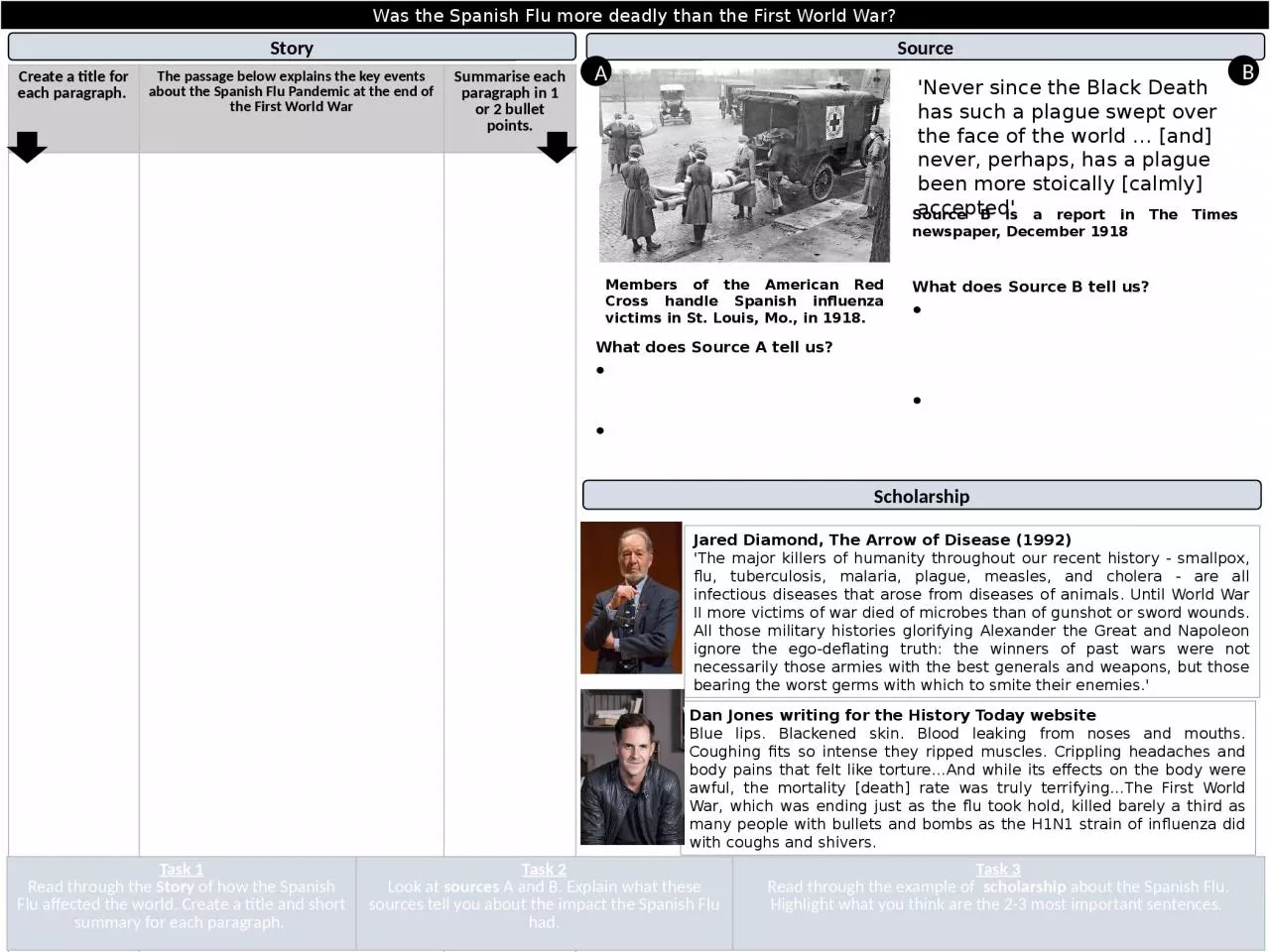

First World War Story Source Scholarship Create a title for each paragraph The passage below explains the key events about the Spanish Flu Pandemic at the end of the First World War Summarise each paragraph in 1 or 2 bullet points ID: 933195
Download Presentation The PPT/PDF document "Was the Spanish Flu more deadly than the" is the property of its rightful owner. Permission is granted to download and print the materials on this web site for personal, non-commercial use only, and to display it on your personal computer provided you do not modify the materials and that you retain all copyright notices contained in the materials. By downloading content from our website, you accept the terms of this agreement.
Slide1
Was the Spanish Flu more deadly than the
First World War?
Story
Source
Scholarship
Create a title for each paragraph. The passage below explains the key events about the Spanish Flu Pandemic at the end of the First World WarSummarise each paragraph in 1 or 2 bullet points.The most serious pandemic of the 20th century was the Spanish Flu of 1918–20. It began just as World War I was ending. This deadly flu virus claimed 50 to 100 million lives (between 3 and 5 per cent of the world's population), making it one of the deadliest diseases in human history. The 1918 flu was first seen in Europe, the USA and parts of Asia. It then spread quickly around the rest of the world. At the time there were no effective drugs or vaccines to treat the flu. One of the reasons it spread so quickly was because soldiers caught it while fighting in WW1. When the war ended they took the germs back home with them. Often they were squashed into ships taking them back to their home countries where germs could spread easily.People did try to help stop it spreading, although they didn’t have the knowledge or technology we have today. People were ordered to wear masks. There are stories in the USA of men being shot dead because they wouldn’t wear a mask. Schools, theatres and businesses were closed and bodies piled up in makeshift morgues.It was nicknamed ‘Spanish flu’ as the first reported cases were in Spain. As this was during World War I, newspapers were censored (Germany, the United States, Britain and France all had media blackouts on news that might lower morale). This meant that although there were flu cases elsewhere, it was the Spanish cases that hit the headlines. One of the first casualties was the King of Spain.Young adults between 20 and 30 years old were often worst affected. People became very ill very quickly. Those fine and healthy at breakfast could be dead by tea-time. Within hours of feeling the first symptoms of fatigue, fever and headache, some victims would rapidly develop pneumonia and start turning blue, due to a shortage of oxygen. They would then struggle for air until they suffocated to death.
Task 1
Read through the
Story of how the Spanish Flu affected the world. Create a title and short summary for each paragraph. Task 2Look at sources A and B. Explain what these sources tell you about the impact the Spanish Flu had.Task 3Read through the example of scholarship about the Spanish Flu. Highlight what you think are the 2-3 most important sentences.
A
B
What does Source B tell us?
Source B is a report in The Times newspaper, December 1918
Members of the American Red Cross handle Spanish influenza victims in St. Louis, Mo., in 1918.
What does Source A tell us?
Jared Diamond, The Arrow of Disease (1992)'The major killers of humanity throughout our recent history - smallpox, flu, tuberculosis, malaria, plague, measles, and cholera - are all infectious diseases that arose from diseases of animals. Until World War II more victims of war died of microbes than of gunshot or sword wounds. All those military histories glorifying Alexander the Great and Napoleon ignore the ego-deflating truth: the winners of past wars were not necessarily those armies with the best generals and weapons, but those bearing the worst germs with which to smite their enemies.'
'Never since the Black Death has such a plague swept over the face of the world … [and] never, perhaps, has a plague been more stoically [calmly] accepted'
Dan Jones writing for the History Today website
Blue lips. Blackened skin. Blood leaking from noses and mouths. Coughing fits so intense they ripped muscles. Crippling headaches and body pains that felt like torture…And while its effects on the body were awful, the mortality [death] rate was truly terrifying…The First World War, which was ending just as the flu took hold, killed barely a third as many people with bullets and bombs as the H1N1 strain of influenza did with coughs and shivers.